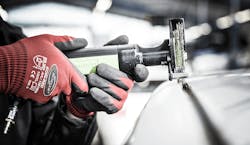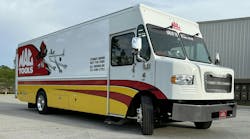Collision repair, often completed by specialty shops, presents a variety of challenges for technicians, which can mean an opportunity for mobile tool distributors. Distributors not currently servicing collision repair shops may be missing out on a significant revenue opportunity.
While collision repair does require some large equipment that is not practical to stock on a tool truck, there are plenty of smaller tools that distributors can carry for collision repair technicians. And, as advanced vehicle technology increases the number of sensors that may be damaged during a crash, you have the opportunity to sell diagnostic scan tools equipped with pre- and post-scan capabilities to collision repair shops as well.
Consider stocking the following product categories to appeal to collision repair technicians:
Dent removal tools
Dent removal tools are a must-have for collision repair technicians. And, there are a variety of options depending on the scope of the repair, type of material and location.
“For minor hail damage on a steel door, a tech might choose to use [a tool such as Dent Fix Equipment’s] Paint-less Dent Repair method, which gently massages and pushes the dent out from the back side, eliminating the need to repaint,” says Geoff Preston, vice president of marketing, Dent Fix Equipment.
“However, if this same damage was located on a part of the vehicle that had no access to the back of the panel, the tech would probably use a glue pulling method with high strength glue, a pull tab and a hand puller. If the severity of the damage was greater, the tech would need to remove the paint from the damaged area, weld a pulling device to the panel, repair the damage and send it to the paint shop for blending,” he explains.
Consider stocking dent pullers for both aluminum and steel, as different materials will require different tools.
Grinders, blasters and sanders
Grinders, blasters and sanders are designed for preparing surfaces for welding, painting or other surface sensitive applications.
“These tools provide an excellent cleaning effect and various degrees of surface finishes ranging from smooth to course textures,” says Michael Fischer, president of Monti Tools. Monti Tools is a manufacturer of professional surface preparation tools.
Welders
Collision repair technicians will frequently face collision damage that needs to be welded back into place, and this gives tool distributors the opportunity to sell equipment that will help them effectively make these repairs.
Multi-function welding machines allow users to work with both steel and aluminum panels for dent repair, so they may be a good fit for a variety of shops. These machines will often have timer and heat settings to allow users to adjust for application-specific needs.
“The H&S welding offering will let a user use MIG or TIG weld steel, aluminum or mixed metals using a welder with filler rods,” says Eric Sponhaltz, national sales and marketing manager, H&S Autoshot.
Kurt Lammon, president of Polyvance, adds that plastic repair is another consideration when selecting a welder for a shop. Polyvance offers a variety of plastic welders developed for the repair of polyurethane bumpers.
“It is useful for both collision and mechanical repair shops,” Lammon says. “It can repair most any plastic on a car, as it features eight different types of plastic welding rods.”
Frame correction tools
Alignment and frame correction tools are large equipment that may be too big to stock on the truck, but are a large ticket item that distributors may be able to assist shop owners with purchasing when they are looking to upgrade their equipment or expand their shop capabilities.
Frame and structural damage is common in a collision, and equipment such as Bee Line’s heavy duty frame correction systems help technicians correct this damage, says Howard Williams, corporate technical sales specialist, Bee Line Company.
Accessories and consumables
In addition to tools specific to collision repair, there are a number of accessories and consumables that will be useful to body shops and collision repair technicians. Consider stocking these items as well to boost sales:
- Lights- you can’t fix what you can’t see, advises Dent Fix Equipment’s Preston. Consider stocking bright LED lights that can mount on multiple surfaces.
- Small consumables, including drill bits, wiggle wire, hot staples, eraser wheels, stud pins, weld keys, glue and plastic welding rods. These items are all small and easy to stock, and are items that technicians will routinely need to buy. These routine sales will help bring traffic to your truck and make you the go-to distributor for collision repair tools.
- Aluminum hammers and hand tools are also helpful for collision repair technicians, and are items that you probably already stock.
- Block sanders in different grits, and replacement sanding pads.
Trends in collision repair
As vehicles evolve, the tools needed to repair them shift, too.
“Aluminum is being used more in the makeup of vehicles on the road today,” says H&S Autoshot’s Sponhaltz. Aluminum, high strength steel and lighter materials require specialty tools for shaping and welding for collision repair.
“My recommendation to distributors is to educate yourself on aluminum and plastic repair procedures and tools to become an authority shops turn to when they can’t find an answer,” adds Dent Fix Equipment’s Preston. “Currently, those two categories have some of the highest growth potential for an equipment distributor. Steel repair tools are definitely not an area to forget about, but if you want to set yourself apart from the crowd, that’s the way to go,” he explains.
Another consideration is the increasing prevalence of automotive structural adhesives, says Monti Tools’ Fischer. These adhesives need to be removed to prepare the surface for reapplication, and specialty tools such as Monti Tools’ MBX and Die Blaster allow technicians to quickly remove structural adhesives and create the required surface preparation for reapplication.
A major trend in the collision repair industry is the increasing use of technologies in mid-range vehicles. In a collision, these sensors can become damaged, leading to a higher demand for technicians familiar with electronics.
“A current demand for documented before and after results in the repair industry (driven by insurance companies) brought about the need for [products such as] Bee Line’s exclusively designed system featuring a single infrared camera that captures the initial conditions of a damaged frame, allowing the operator to determine what corrective measures need to be taken,” says Bee Line’s Williams.
Using tools that offer before and after repair documentation helps streamline diagnostics and ensure a complete repair.
Selling tips and tricks
The key to selling any tool is to help technicians (and for large equipment, shop owners) understand how this tool will help them work more efficiently and complete repairs more easily.
Ask the customer questions about the type of work they regularly perform: auto body repairs, restorations, or customizations, suggests Monti Tools’ Fischer. What tools are they currently using, and what problems are they running into with those tools?
“Ask if the customer is open to a better way of doing things in this respect,” Fischer says. Then, recommend the tool that will best meet their needs, based on their application.
Determine what types of materials your customers are working with. Aluminum? Mixed metals? Plastic? You have an opportunity to suggest specialty tools for working on each one, and if the shop doesn’t currently have the tools to work on materials that are becoming more mainstream, such as aluminum, explain the value that adding that toolset would bring to the shop, says H&S Autoshot’s Sponhaltz.
“Always provide an ROI/payback analysis,” adds Bee Line’s Williams. “Have a clear understanding of the application, and recommend the system that best meets their needs, gets the job done correctly and will maximize the shop’s productivity and profitability.”
When selling collision repair equipment, it’s important to consider whether the tool can produce the quality of repair to meet or exceed the specifications of the manufacturer. “Lowering costs is important, but not if it sacrifices the quality of the repair,” Dent Fix Equipment’s Preston says. “Otherwise, that repair might come back to the shop, but this time at the shop’s expense.”
He adds that distributors should strive to educate themselves and be a knowledge resource that shops can depend on when trying to expand their abilities and achieve their goals. Be knowledgeable of different repair solutions, and be aware of how and whether they will work for your customers. Preston notes that it is often helpful to have a Good, Better and Best option available for popular collision repair equipment to accommodate all budgets.
Conclusion
Collision repair shops offer a variety of new revenue opportunities for distributors. Because collision repair shops see a lot of new-model vehicles, there is potential for knowledgeable distributors to help shops navigate the changing collision repair industry by recommending innovative products and solutions to their current problems.


